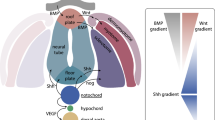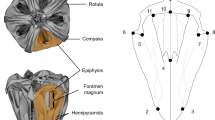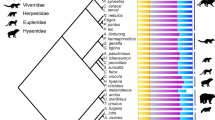Abstract
Does a modular body organization present a challenge for developmental control? We investigate the idea of a possible developmental cost of modularity by examining the relationship between modularity and developmental stability in a multi-segmented arthropod taxon: the geophilomorph centipedes. In a sample of eight species, we tested the correlation between developmental stability, estimated from measures of translational fluctuating asymmetry, and the number of trunk segments and some other morphological traits, both at the species and individual levels. We found sizeable differences in size and shape patterns of variation at the level of species. However, we did not find any clear evidence of correlation between fluctuating asymmetry and the number of trunk segments or the other morphological traits considered. Thus, our results provide no support to the idea of a possible trade-off between the cardinality of a modular system and the level of developmental precision in the phenotypic expression of its modules. The results of this exploratory study invite further investigations of patterns of translational fluctuating asymmetry in segmented animals and other modular organisms, as these have the potential to reveal features of developmental stability that cannot be captured by the study of bilateral asymmetry alone.




Similar content being viewed by others
References
Aparicio JM (1998) Patterns of fluctuating asymmetry in developing primary feathers: a test of the compensational growth hypothesis. Proc R Soc B 265:2353–2357
Astaurov BL (1930) Analyse der erblichen Störungsfälle der bilateralen Symmetrie. Z Indukt Abstamm Vererbungsl 55:183–262
Berto D, Fusco G, Minelli A (1997) Segmental units and shape control in Chilopoda. Entomol Scand 51(Suppl):61–70
Bonato L, Minelli A (2014) Chilopoda geophilomorpha of Europe: a revised list of species, with taxonomic and nomenclatorial notes. Zootaxa 3770:1–136
Bonato L, Edgecombe GD, Zapparoli M (2011) Chilopoda—taxonomic overview. In: Minelli A (ed) Treatise on zoology—anatomy, taxonomy, biology, vol 1, The Myriapoda. Brill, Leiden, pp 363–443
Bonato L, Drago L, Murienne J (2014) Phylogeny of Geophilomorpha (Chilopoda) inferred from new morphological and molecular evidence. Cladistics 30:485–507
Brena C (2014) The embryoid development of Strigamia maritima and its bearing on post-embryonic segmentation of geophilomorph centipedes. Front Zool 11:58
Brena C (2015) Myriapoda. In: Wanninger (ed) Evolutionary developmental biology of invertebrates, 3: Ecdysozoa I: non-Tetraconata. Springer Verlag, Berlin, pp 141–189
Clarke GM (1998) The genetic basis of developmental stability. IV. Individual and population asymmetry parameters. Heredity 80:553–561
Clune J, Mouret JB, Lipson H (2013) The evolutionary origins of modularity. Proc R Soc B 280:20122863
R Core Team (2015) R: A language and environment for statistical computing. R Foundation for Statistical Computing, Vienna. Available at http://www.R-project.org/
Debat V, David P (2001) Mapping phenotypes: canalization, plasticity and developmental stability. Trends Ecol Evol 16:555–561
Debat V, Peronnet F (2013) Asymmetric flies: the control of developmental noise in Drosophila. Fly 7:70–77
Debat V, Bloyer S, Faradji F, Gidaszewski N, Navarro N, Orozco-terWengel P, Ribeiro V, Schlötterer C, Deutsch JS, Peronnet F (2011) Developmental stability: a major role for Cyclin G in Drosophila melanogaster. PLoS Genet 7, e1002314
Del Latte L, Bortolin F, Rota-Stabelli O, Fusco G, Bonato L (2015) Molecular-based estimate of species number, phylogenetic relationships and divergence times for the genus Stenotaenia (Chilopoda, Geophilomorpha) in the Italian region. Zookeys 510:31–47
Félix MA, Barkoulas M (2015) Pervasive robustness in biological systems. Nat Rev Genet 16:483–496
Freeman DC, Graham JH, Emlen JM (1993) Developmental stability in plants: symmetries, stress and epigenesis. Genetica 89:97–119
Fusco G (2005) Trunk segment numbers and sequential segmentation in myriapods. Evol Dev 7:608–617
Fusco G, Minelli A (2000a) Developmental stability in geophilomorph centipedes. Fragm Faun 43(Suppl):73–82
Fusco G, Minelli A (2000b) Measuring morphological complexity of segmented animals: centipedes as model systems. J Evol Biol 13:38–46
Fusco G, Minelli A (2010) Phenotypic plasticity in development and evolution: facts and concepts. Philos Trans R Soc B 365:547–556
Fusco G, Minelli A (2013) Arthropod body segments and tagmata. In: Minelli A, Boxshall G, Fusco G (eds) Arthropod biology and evolution, Molecules, development, morphology. Springer Verlag, Berlin, pp 197–221
Fusco G, Brena C, Minelli A (2000) Cellular processes in the growth of lithobiomorph centipedes (Chilopoda: Lithobiomorpha). A cuticular view. Zool Anz 239:91–102
Fusco G, Leśniewska M, Congiu L, Bertorelle G (2015) Population genetic structure of a centipede species with high levels of developmental instability. PLoS ONE 10, e0126245
Graham JH, Raz S, Hel-Or H, Nevo E (2010) Fluctuating asymmetry: methods, theory, and applications. Symmetry 2:466–540
Horneland EO, Meidell B (2009) Postembryonic development of Strigamia maritima (Leach, 1817) (Chilopoda: Geophilomorpha: Linotaeniidae) with emphasis on how to separate the different stadia. Soil Organ 81:373–386
Kembel SW, Cowan PD, Helmus MR, Cornwell WK, Morlon H, Ackerly DD, Blomberg SP, Webb CO (2010) Picante: R tools for integrating phylogenies and ecology. Bioinformatics 26:1463–1464
Kent JT, Mardia KV (2001) Shape, procrustes tangent projections and bilateral symmetry. Biometrika 88:469–485
Klaus AV, Schawaroch V (2006) Novel methodology utilizing confocal laser scanning microscopy for systematic analysis in arthropods (Insecta). Integr Comp Biol 46:207–214
Klingenberg CP (2003) A developmental perspective on developmental instability: theory, models and mechanisms. In: Polak M (ed) Developmental instability: causes and consequences. Oxford University Press, New York, pp 14–34
Klingenberg CP (2015) Analyzing fluctuating asymmetry with geometric morphometrics: concepts, methods, and applications. Symmetry 7:843–934
Klingenberg CP, McIntyre GS (1998) Geometric morphometrics of developmental instability: analyzing patterns of fluctuating asymmetry with procrustes methods. Evolution 52:1363–1375
Klingenberg CP, Nijhout HF (1998) Competition among growing organs and developmental control of morphological asymmetry. Proc R Soc Lond B 265:1135–1139
Klingenberg CP, Barluenga M, Meyer A (2002) Shape analysis of symmetric structures: quantifying variation among individuals and asymmetry. Evolution 56:1909–1920
Leamy L (1984) Morphometric studies in inbred and hybrid house mice. V. Directional and fluctuating asymmetry. Am Nat 123:579–593
Leamy L (1993) Morphological integration of fluctuating asymmetry in the mouse mandible. Genetica 89:139–153
Leśniewska M, Bonato L, Minelli A, Fusco G (2009) Trunk anomalies in the centipede Stigmatogaster subterranea provide insight into late-embryonic segmentation. Arthropod Struct Dev 38:417–426
Mardia KV, Bookstein FL, Moreton IJ (2000) Statistical assessment of bilateral symmetry of shapes. Biometrika 87:285–300
Minelli A, Fusco G (2004) Evo-devo perspectives on segmentation: model organisms, and beyond. Trends Ecol Evol 19:423–429
Minelli A, Fusco G (2013) Homology. In: Kampourakis K (ed) The philosophy of biology: a companion for educators. Springer Verlag, Berlin Heidelberg, pp 289–322
Moretto M, Minelli A, Fusco G (2015) Cell size versus body size in geophilomorph centipedes. Sci Nat 102:16
Murienne J, Edgecombe GD, Giribet G (2010) Including secondary structure, fossils and molecular dating in the centipede tree of life. Mol Phylogenet Evol 57:301–313
Nijhout HF, Davidowitz G (2003) Developmental perspectives on phenotypic variation, canalization, and fluctuating asymmetry. In: Polak M (ed) Developmental instability: causes and consequences. Oxford University Press, New York, pp 3–13
Orme D, Freckelton R, Thomas G, Petzoldt T, Fritz S, Isaac N, Pearse W (2013) Caper: comparative analyses of phylogenetics and evolution in R. Available at: http://CRAN.R-project.org/package=caper
Palmer AR, Strobeck C (1986) Fluctuating asymmetry: measurement, analysis, patterns. Annu Rev Ecol Syst 17:391–421
Palmer AR, Strobeck C (2003) Fluctuating asymmetry analyses revisited. In: Polak M (ed) Developmental instability: causes and consequences. Oxford University Press, New York, pp 279–319
Piscart C, Moreteau J-C, Beisel J-N (2005) Decrease of fluctuating asymmetry among larval instars in an aquatic, holometabolous insect. C R Biol 328:912–917
Polak M (ed) (2003) Developmental instability: causes and consequences. Oxford University Press, New York
Raz S, Schwartz NP, Mienis HK, Nevo E, Graham JH (2012) Fluctuating helical asymmetry and morphology of snails (Gastropoda) in divergent microhabitats at ‘Evolution Canyons I and II’, Israel. PLoS ONE 7, e41840
Rohlf FJ (2015) The TPS series of software. Hystrix 26:9–12
Savriama Y, Klingenberg CP (2011) Beyond bilateral symmetry: geometric morphometric methods for any type of symmetry. BMC Evol Biol 11:280
Savriama Y, Gómez JM, Perfectti F, Klingenberg CP (2012) Geometric morphometrics of corolla shape: dissecting components of symmetric and asymmetric variation in Erysimum mediohispanicum (Brassicaceae). New Phytol 196:945–954
Savriama Y, Stige LC, Gerber S, Pérez T, Alibert P, David B (2015) Impact of sewage pollution on two species of sea urchins in the Mediterranean Sea (Cortiou, France): radial asymmetry as a bioindicator of stress. Ecol Indic 54:39–47
Schlosser G, Wagner GP (eds) (2004) Modularity in development and evolution. University of Chicago Press, Chicago
Swaddle JP, Witter MS (1997) On the ontogeny of developmental stability in a stabilized trait. Proc R Soc Lond B 264:329–334
Turcato A, Fusco G, Minelli A (1995) The sternal pore areas of geophilomorph centipedes (Chilopoda: Geophilomorpha). Zool J Linn Soc 115:185–209
Whitlock M (1996) The heritability of fluctuating asymmetry and the genetic control of developmental stability. Proc R Soc B 263:849–853
Acknowledgments
We thank Lucio Bonato for help with sample choice and for fruitful discussions, Małgorzata Leśniewska for kindly providing S. souletina and S. subterranea specimens and Fig. 1, Diego Maruzzo for the assistance with CLSM, Enrico L. Rezende for precious advice on the pgls analysis, and two anonymous referees for their insightful comments on a previous version of the article. This work has been supported by a grant (CPDA115439/11) from the Italian Ministry of Education, University and Research (MIUR) to GF.
Author information
Authors and Affiliations
Corresponding author
Additional information
Communicated by Nico Posnien and Nikola-Michael Prpic
This article is part of the Special Issue “Size and Shape: Integration of morphometrics, mathematical modelling, developmental and evolutionary biology”, Guest Editors: Nico Posnien—Nikola-Michael Prpic
Vincent Debat and Giuseppe Fusco contributed equally to this work.
Rights and permissions
About this article
Cite this article
Savriama, Y., Vitulo, M., Gerber, S. et al. Modularity and developmental stability in segmented animals: variation in translational asymmetry in geophilomorph centipedes. Dev Genes Evol 226, 187–196 (2016). https://doi.org/10.1007/s00427-016-0538-3
Received:
Accepted:
Published:
Issue Date:
DOI: https://doi.org/10.1007/s00427-016-0538-3




